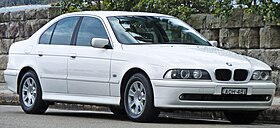BMW 5 Series (E39)
| BMW 5 Series (E39) | |
|---|---|
 |
|
| Overview | |
| Manufacturer | BMW |
| Production | September 1995 – June 2003 (sedan) June 1996 – April 2004 (wagon) |
| Assembly | Germany: Dingolfing Mexico: Toluca Russia: Kaliningrad |
| Designer | Joji Nagashima (1992) |
| Body and chassis | |
| Class | Mid-size luxury / Executive car (E) |
| Body style | 4-door sedan 5-door estate |
| Layout | FR layout |
| Powertrain | |
| Engine |
Petrol: 2.0 - 2.8 L M52 I6 2.0 - 3.0 L M54 I6 3.5-4.4 L M62 V8 4.9 L S62 V8 Diesel: 2.0 L M47 turbo I4 2.5 L M51 turbo I6 2.5 - 3.0 L M57 turbo I6 |
| Dimensions | |
| Wheelbase | 2,830 mm (111.4 in) |
| Length | sedan: 4,775 mm (188.0 in) wagon: 4,806 mm (189.2 in) |
| Width | 1,801 mm (70.9 in) |
| Height | sedan: 1,435 mm (56.5 in) wagon: 1,440 mm (56.7 in) |
| Curb weight | 1,480–1,800 kg (3,260–3,970 lb) |
| Chronology | |
| Predecessor | BMW 5 Series (E34) |
| Successor | BMW 5 Series (E60) |
The BMW E39 is the fourth generation of BMW 5 Series, which was sold from 1995 to 2004. It was launched in the sedan body style, with the wagon/estate body style (marketed as "Touring") introduced in 1996. The E39 was replaced by the E60 in 2003, however E39 Touring models remained in production until 2004.
The E39 was the first 5 Series to use aluminium components in the front suspension. The proportion of chassis components using aluminium significantly increased for the E39, in order to reduce weight. It was also the first 5 Series where a four-cylinder diesel engine was available.
V8 models use recirculating ball steering (as per previous 5 Series generations), however rack and pinion steering was used for the first time, in the four-cylinder and six-cylinder models. Unlike its E34 predecessor and E60 successor, the E39 was not available with all-wheel drive.
The M5 sedan was introduced in 1998, powered by the 4.9-litre S62 V8 engine.
Development for the E34's successor began in early 1989, (internally known as "Entwicklung 39") and ended in 1995. The final design by Joji Nagashima was selected in June 1992 and later frozen for production under new design chief Chris Bangle. With design selection in 1992, the series development phase began and took 39 months till start of production. The domestic German design patent was filed on 20 April 1994, utilizing an E39 prototype.
In May 1995 BMW published the first official photos of the E39. The E39 premiered in September 1995 at the Frankfurt Motor Show (IIA). In December 1995 sales began on the European mainland.
The first pilot production models were built in February 1995, with full-scale production starting later in the year. Most cars were built at the Dingolfing factory.
Compared with its E34 predecessor, the E39 wheelbase grew by 68 mm (2.7 in) and overall length by 55 mm (2.2 in). Torsional rigidity was increased over the E34 by 40 percent, which reduces body flex and allows the suspension to operate more accurately, also improving ride quality. Due to a stiffer body shell, the weight of the chassis increased by 10 kg (22 lb), which is offset by the reduced weight of some aluminium suspension components.
...
Wikipedia
